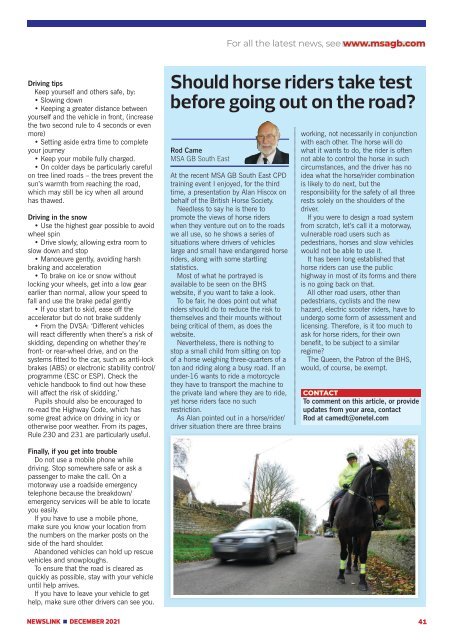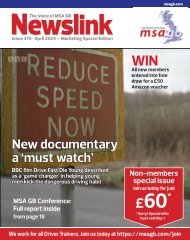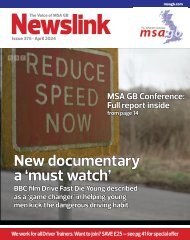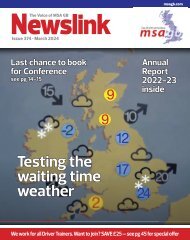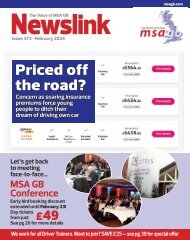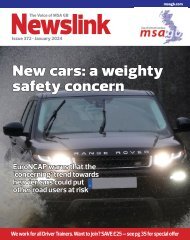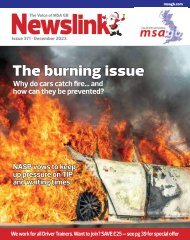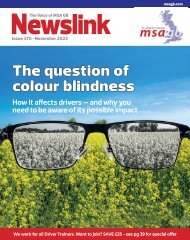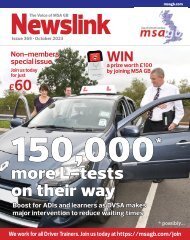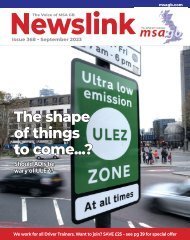Newslink December 2021
Magazine for Motor Schools Association of Great Britain, road safety, driving training and testing
Magazine for Motor Schools Association of Great Britain, road safety, driving training and testing
Create successful ePaper yourself
Turn your PDF publications into a flip-book with our unique Google optimized e-Paper software.
For all the latest news, see www.msagb.com<br />
Driving tips<br />
Keep yourself and others safe, by:<br />
• Slowing down<br />
• Keeping a greater distance between<br />
yourself and the vehicle in front, (increase<br />
the two second rule to 4 seconds or even<br />
more)<br />
• Setting aside extra time to complete<br />
your journey<br />
• Keep your mobile fully charged.<br />
• On colder days be particularly careful<br />
on tree lined roads – the trees prevent the<br />
sun’s warmth from reaching the road,<br />
which may still be icy when all around<br />
has thawed.<br />
Driving in the snow<br />
• Use the highest gear possible to avoid<br />
wheel spin<br />
• Drive slowly, allowing extra room to<br />
slow down and stop<br />
• Manoeuvre gently, avoiding harsh<br />
braking and acceleration<br />
• To brake on ice or snow without<br />
locking your wheels, get into a low gear<br />
earlier than normal, allow your speed to<br />
fall and use the brake pedal gently<br />
• If you start to skid, ease off the<br />
accelerator but do not brake suddenly<br />
• From the DVSA: ‘Different vehicles<br />
will react differently when there’s a risk of<br />
skidding, depending on whether they’re<br />
front- or rear-wheel drive, and on the<br />
systems fitted to the car, such as anti-lock<br />
brakes (ABS) or electronic stability control/<br />
programme (ESC or ESP). Check the<br />
vehicle handbook to find out how these<br />
will affect the risk of skidding.’<br />
Pupils should also be encouraged to<br />
re-read the Highway Code, which has<br />
some great advice on driving in icy or<br />
otherwise poor weather. From its pages,<br />
Rule 230 and 231 are particularly useful.<br />
Should horse riders take test<br />
before going out on the road?<br />
Rod Came<br />
MSA GB South East<br />
At the recent MSA GB South East CPD<br />
training event I enjoyed, for the third<br />
time, a presentation by Alan Hiscox on<br />
behalf of the British Horse Society.<br />
Needless to say he is there to<br />
promote the views of horse riders<br />
when they venture out on to the roads<br />
we all use, so he shows a series of<br />
situations where drivers of vehicles<br />
large and small have endangered horse<br />
riders, along with some startling<br />
statistics.<br />
Most of what he portrayed is<br />
available to be seen on the BHS<br />
website, if you want to take a look.<br />
To be fair, he does point out what<br />
riders should do to reduce the risk to<br />
themselves and their mounts without<br />
being critical of them, as does the<br />
website.<br />
Nevertheless, there is nothing to<br />
stop a small child from sitting on top<br />
of a horse weighing three-quarters of a<br />
ton and riding along a busy road. If an<br />
under-16 wants to ride a motorcycle<br />
they have to transport the machine to<br />
the private land where they are to ride,<br />
yet horse riders face no such<br />
restriction.<br />
As Alan pointed out in a horse/rider/<br />
driver situation there are three brains<br />
working, not necessarily in conjunction<br />
with each other. The horse will do<br />
what it wants to do, the rider is often<br />
not able to control the horse in such<br />
circumstances, and the driver has no<br />
idea what the horse/rider combination<br />
is likely to do next, but the<br />
responsibility for the safety of all three<br />
rests solely on the shoulders of the<br />
driver.<br />
If you were to design a road system<br />
from scratch, let’s call it a motorway,<br />
vulnerable road users such as<br />
pedestrians, horses and slow vehicles<br />
would not be able to use it.<br />
It has been long established that<br />
horse riders can use the public<br />
highway in most of its forms and there<br />
is no going back on that.<br />
All other road users, other than<br />
pedestrians, cyclists and the new<br />
hazard, electric scooter riders, have to<br />
undergo some form of assessment and<br />
licensing. Therefore, is it too much to<br />
ask for horse riders, for their own<br />
benefit, to be subject to a similar<br />
regime?<br />
The Queen, the Patron of the BHS,<br />
would, of course, be exempt.<br />
CONTACT<br />
To comment on this article, or provide<br />
updates from your area, contact<br />
Rod at camedt@onetel.com<br />
Finally, if you get into trouble<br />
Do not use a mobile phone while<br />
driving. Stop somewhere safe or ask a<br />
passenger to make the call. On a<br />
motorway use a roadside emergency<br />
telephone because the breakdown/<br />
emergency services will be able to locate<br />
you easily.<br />
If you have to use a mobile phone,<br />
make sure you know your location from<br />
the numbers on the marker posts on the<br />
side of the hard shoulder.<br />
Abandoned vehicles can hold up rescue<br />
vehicles and snowploughs.<br />
To ensure that the road is cleared as<br />
quickly as possible, stay with your vehicle<br />
until help arrives.<br />
If you have to leave your vehicle to get<br />
help, make sure other drivers can see you.<br />
NEWSLINK n DECEMBER <strong>2021</strong><br />
41


